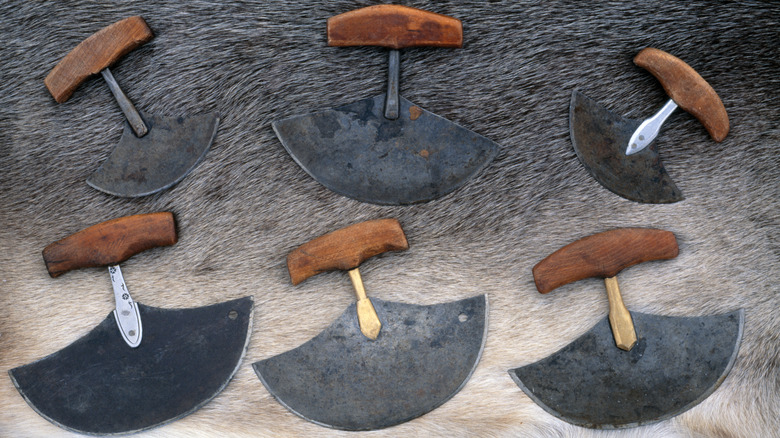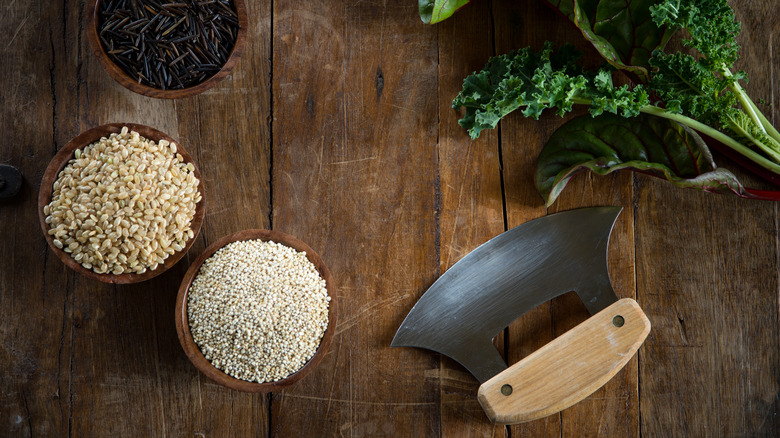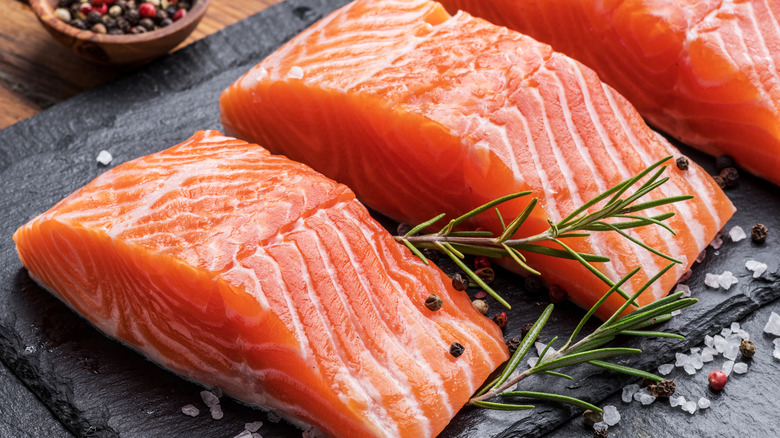The Inuit Ulu Knife Delivers Incomparable Cuts In The Kitchen
Dating back over 2 million years, knives have been in existence since before modern humans. They've grown with us, changing and developing across time and culture. In fact, in 2005, Forbes ranked knives first on its list of the 20 most important tools.
Often, the designs, materials, and purposes of these knives are interconnected with their cultural histories. As Culture Trip writes, the long, willowy Japanese yanagiba knife was developed for cutting fish, while the short, stubby mushroom knife was used for foraging in Central European forests.
Like the yanagiba knife and the mushroom knife, the Inuit ulu knife tells a cultural history. According to an article in "Études Inuit Studies," Indigenous cultures throughout the Arctic have used ulu knives for millennia. The earliest ulus likely originated around 4,500 years ago in the area surrounding the Bering Strait. While ulu knives are often used for cutting fish, they're remarkably versatile tools that serve an important role in Inuit culture.
What is an ulu knife?
While there are many different kinds of ulu – "Études Inuit Studies" cites at least ten distinct variations — ulu knives are distinctly different from the knives found in Western kitchens. Ulu knives typically have a curved, crescent-shaped blade attached to a T-shaped handle. The knives are made from a wide variety of materials. Often, ulu handles are made from wood, bone, or ivory (per the University of Waterloo).
Since early Inuit communities lacked the technology to smelt metal, ulu knives were historically made from slate. However, meteorites and naturally-occurring deposits provided iron and copper for ulu knives, too. Archeological evidence shows that these metal knives traveled across the arctic through trade routes.
Traditionally, ulu knives were used by women. They were passed down from mother to daughter, considered family heirlooms, or crafted by family members. Traditionally, ulu knives were often made to fit the hand of the woman it was made for (via "Études Inuit Studies"). Even today, they're a mainstay in Inuit kitchens. It's not uncommon to have multiple ulu knives in different shapes and sizes, used for different tasks.
How are ulu knives used?
Historically, fishing was an important aspect of life for Inuit communities. In an Eater article, Inuit writer Laureli Ivanoff explained that she grew up watching her mother clean salmon with an ulu. In Unalakleet, the Alaskan community she grew up in, Inuit families spent the summer months catching, cleaning, cooking, and preserving salmon.
Since Inuit women spend hours skinning and boning hundreds of fish, ulu knives were designed to be both precise and easy on the hands. Highly ergonomic, ulu knives put pressure on the wrist, rather than the elbow.
According to Alaska Public Media, salmon processing is still an integral part of life for many Alaskan Natives. It's not just about food, though. For many modern Inuits, fishing with traditional methods is a way to connect with their heritage and community. In Yup'ik culture, the fish that women clean and preserve are shared with community members who are disabled, elderly, or unable to fish on their own.
Ulu knives aren't just used for salmon, though. Ivanoff notes that Inuit women traditionally use their ulu knives for a wide variety of purposes, from tanning leather to chopping nuts, herbs, and vegetables.
Why should you use an ulu knife?
While many Inuit families have replaced traditional tools with modern alternatives, the ulu is still common in Inuit kitchens, per Eater. The knife's practicality can't be beat, and its unique design has begun to gain popularity throughout the world. After all, they're versatile tools even outside the milieu of Inuit culture. Ulu knives are perfect for cutting brownies or as an alternative to a pizza cutter.
While companies outside of the Inuit community have appropriated the Ulu knife for mass production, the tradition of hand-crafting ulu knives lives on. Like his ancestors, Inuit wood and metal worker Kenneth Ingniqjuk Piugattuk Mackay started making ulu knives for family members. However, he soon realized that there was so much demand that he founded Urban Inuk, where he sells ulu blades made using traditional methods.
Since ulu knives have an important cultural history, do your research and try to buy from an Inuit company, like Urban Inuk or Artic Spirit Gallery, where you can find hand-made knives.



